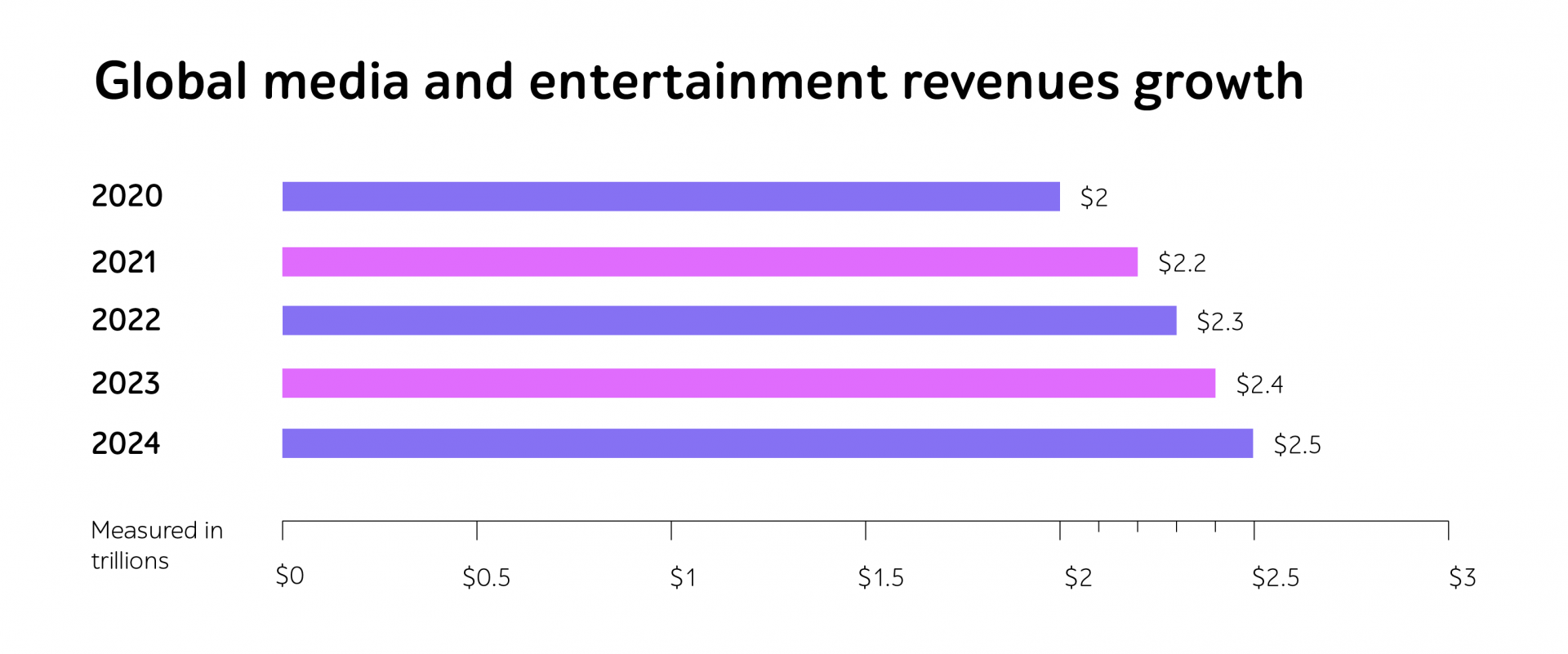
QA for media and entertainment
Lockdowns, digital transformation, massive migration to the online space, changing trends and end-user needs…All this makes companies and enterprises from the media and entertainment industry re-image their business models and embrace novel software development approaches to stay at the top of the competition.
Being limited to harnessing various outdoor entertainment activities, people seek options on the Internet. Alongside applications of day-to-day tasks performing, an extensive range of media and entertainment solutions optimized to modern requirements has emerged.
During 2020, the businesses with mobile apps at the core focus became leading ones, as App Annie’s State of Mobile 2020 report indicates. The pervasive usage of portable devices is also reinforced by the worldwide stay-at-home period. People are more and more involving in digital entertainment, namely gaming, podcasts, audio streaming, and many more.
Within such a high demand for media and entertainment applications, ensuring flawless operation is a silver bullet. How can companies deliver impeccable software products and meet customers’ needs?
Software testing is a way out. Get to know in the article our insights on:
- Tendencies of the industry
- QA as a must-have for media and entertainment solutions’ development
- A comprehensive software testing pattern for media and entertainment.
A new personalized era of media and entertainment
Within the modern market’s tenets and changed customer behavior, end users are geared towards enjoying media experiences uniquely adjusted to their personal preferences, contexts, and schedules.
Now, digitally empowered users want to exert greater control over what content to watch and when. This paves the way for developing software products in conformity with consumers’ wishes and needs. However, there is no one-size-fits-all way of how to gratify all the end users.
Companies should implement novel solutions that help make one’s media space personalized. Amid such innovations, AI algorithms are handy to gather personal data, process it, and provide consumers with new content.
People are more and more rejecting traditional TV bundles and harnessing specific ones through various over-the-top media services. OTT platforms, like Netflix or Hulu, have become a trend in recent years. Statista’s report indicates 74% of US consumers had a video streaming subscription in 2019, and that is an increase of more than 20% in four years.
Further parameters of the shift to active individualized consumption can be seen in the elevation of the smart home building. The core figure here is a smart speaker. Noteworthy is its usage is growing by leaps and bounds. By 2025, 75% of the US households will have a smart speaker in utilization, as Loup Ventures forecast highlights.
As they proliferate, smart speakers can become a conduit to the new frontiers for competition in the burgeoning industry of voice-related media, namely podcasts, music, and news.
Video games, especially eSport, take a substantial part of the media and entertainment industry. Assembling thousands of players and watchers, mobile gaming is becoming a new pillar of the eSport business. It also contributes to a huge jump in live viewership numbers for mobile eSports that have increased by 600% in 2019 compared to the previous year.
Therefore, the media and entertainment sphere encompasses almost every person, and to make end users feel confident in their media experience, IT solutions are to be tested appropriately.
Why test this non-life-threatening sector?
Many companies believe an application not dealing with someone’s health or money doesn’t require proper testing before going to production. Despite the field’s non-responsibility for lives and non-guidance to certain standards, as eHealth and BFSI industries follow, the media and entertainment sector is one of the most complex ones. Within an extremely high market competition, it embraces dozens of content types and an extensive range of devices.
According to PwC Global Entertainment & Media Outlook 2020-2024, revenues of the global media and entertainment industry are rising steadily that means it is getting harder to be ahead of the competitors.

Now, alongside improving content quality and increasing views and subscriptions, it is crucial to ensure IT solutions’ flawless operation to allure more customers. As the market contains thousands of options, end users have become more fastidious in choosing entertaining applications.
A seamless user experience and immersive content are the core concepts of media and entertainment business success. Software testing helps get confident in the delivery of upscale and competitive products providing end users with an impeccable digital entertainment journey.
Even strict budget and time constraints can’t prevent QA introduction. Due to Agile methodologies at the forefront, software testing adjusts to the circumstances and stays on guard of the IT products’ quality.
Applying holistic QA to soaring numbers of customers
Software testing is all about spotting defects sharply, enhancing IT solutions’ quality, and maintaining their adequate level. Alongside its apparent purpose, QA assists in deriving desired business objectives. Within the main media and entertainment goal of expanding consumption, quality assurance can help to reach it through proper and thorough testing services.
Improved CX is a cornerstone of media and entertainment business success, so a1qa’s experts recommend performing a comprehensive QA bundle.
- Functional testing. Flawless and accurate operation plays a pivotal role in any-industry applications. By executing a full scope (from smoke to exploratory testing), one can timely detect errors and verify novel functionality didn’t affect the developed features.
- Usability and GUI testing. Design and user-friendly interface are other aspects of end-users’ involvement. Usability testing results provide 360-degree visibility into how the customers see your applications and an understanding of the journey they want through the products.
- Mobile testing. As there is a tendency to use portable devices, it is lean to introduce mobile testing encompassing cross-platform and cross-browser testing. Harnessing real devices ensures glitches don’t appear on customers’ phones or tablets. Providing complex QA assistance to a developer of online casino games, a1qa leveraged 110+ mobile devices to cover all possible defects and guarantee consummate UX.
- Performance testing. With due regard to massive media and entertainment solutions usage, the number of consumers is steadily growing. Software behavior evaluation under an expected load, the upper capacity limits identification, simulating users’ actions — these all are about ensuring flawless real-life user journeys. However, performing some testing types is not enough. In order to get a high-end IT solution and stay at the top of this competitive market, companies should consider how QA processes are carried out. Keeping in mind all the extensive expertise, we do believe they require to be optimized and adjusted to modern working approaches.
Shift-left testing is one of the progressive strategies in an Agile world. Putting testing activities at the very project start, companies can avoid expensive post hoc defect fixing and provide a robust ground for thorough testing. Also, within a heavy workload and frequent releases, businesses should be faster while maintaining high software quality. Automated testing is a way out. Alongside streamlining testing processes and freeing up manual QA engineers, it contributes to QA costs reduction and time to market acceleration.
Summing up
The world is getting more and more personal, and the media and entertainment industry is no exception. Despite the field doesn’t deal with health or finances, it is more complex assembling thousands of users.
To reach a win-win solution between them, companies should consider trends amid consumers and innovative approaches to work. AI, OTT services, eSport, and voice streaming are getting more pervasive. Through a proper testing bundle and up-to-date working strategies, one can derive desired business outcomes and deliver upscale solutions meeting end-user needs.
Get hold of us to have a talk with a1qa’s experts on how to provide media and entertainment applications with stellar operation and improved CX.








